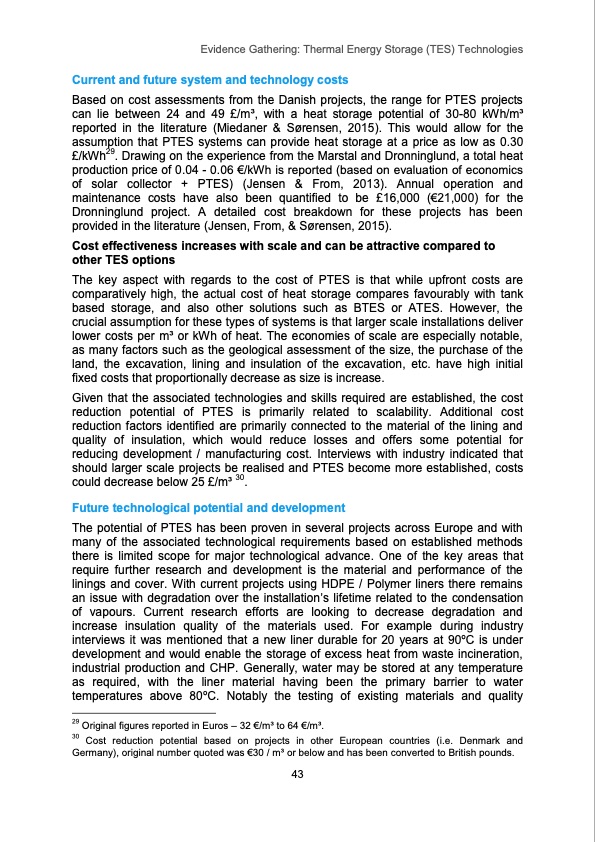
PDF Publication Title:
Text from PDF Page: 044
Evidence Gathering: Thermal Energy Storage (TES) Technologies Current and future system and technology costs Based on cost assessments from the Danish projects, the range for PTES projects can lie between 24 and 49 £/m3, with a heat storage potential of 30-80 kWh/m3 reported in the literature (Miedaner & Sørensen, 2015). This would allow for the assumption that PTES systems can provide heat storage at a price as low as 0.30 £/kWh29. Drawing on the experience from the Marstal and Dronninglund, a total heat production price of 0.04 - 0.06 €/kWh is reported (based on evaluation of economics of solar collector + PTES) (Jensen & From, 2013). Annual operation and maintenance costs have also been quantified to be £16,000 (€21,000) for the Dronninglund project. A detailed cost breakdown for these projects has been provided in the literature (Jensen, From, & Sørensen, 2015). Cost effectiveness increases with scale and can be attractive compared to other TES options The key aspect with regards to the cost of PTES is that while upfront costs are comparatively high, the actual cost of heat storage compares favourably with tank based storage, and also other solutions such as BTES or ATES. However, the crucial assumption for these types of systems is that larger scale installations deliver lower costs per m3 or kWh of heat. The economies of scale are especially notable, as many factors such as the geological assessment of the size, the purchase of the land, the excavation, lining and insulation of the excavation, etc. have high initial fixed costs that proportionally decrease as size is increase. Given that the associated technologies and skills required are established, the cost reduction potential of PTES is primarily related to scalability. Additional cost reduction factors identified are primarily connected to the material of the lining and quality of insulation, which would reduce losses and offers some potential for reducing development / manufacturing cost. Interviews with industry indicated that should larger scale projects be realised and PTES become more established, costs could decrease below 25 £/m3 30. Future technological potential and development The potential of PTES has been proven in several projects across Europe and with many of the associated technological requirements based on established methods there is limited scope for major technological advance. One of the key areas that require further research and development is the material and performance of the linings and cover. With current projects using HDPE / Polymer liners there remains an issue with degradation over the installation’s lifetime related to the condensation of vapours. Current research efforts are looking to decrease degradation and increase insulation quality of the materials used. For example during industry interviews it was mentioned that a new liner durable for 20 years at 90oC is under development and would enable the storage of excess heat from waste incineration, industrial production and CHP. Generally, water may be stored at any temperature as required, with the liner material having been the primary barrier to water temperatures above 80oC. Notably the testing of existing materials and quality 29 Original figures reported in Euros – 32 €/m3 to 64 €/m3. 30 Cost reduction potential based on projects in other European countries (i.e. Denmark and Germany), original number quoted was €30 / m3 or below and has been converted to British pounds. 43PDF Image | Thermal Energy Storage (TES) Technologies

PDF Search Title:
Thermal Energy Storage (TES) TechnologiesOriginal File Name Searched:
DELTA_EE_DECC_TES_Final__1_.pdfDIY PDF Search: Google It | Yahoo | Bing
Turbine and System Plans CAD CAM: Special for this month, any plans are $10,000 for complete Cad/Cam blueprints. License is for one build. Try before you buy a production license. More Info
Waste Heat Power Technology: Organic Rankine Cycle uses waste heat to make electricity, shaft horsepower and cooling. More Info
All Turbine and System Products: Infinity Turbine ORD systems, turbine generator sets, build plans and more to use your waste heat from 30C to 100C. More Info
CO2 Phase Change Demonstrator: CO2 goes supercritical at 30 C. This is a experimental platform which you can use to demonstrate phase change with low heat. Includes integration area for small CO2 turbine, static generator, and more. This can also be used for a GTL Gas to Liquids experimental platform. More Info
Introducing the Infinity Turbine Products Infinity Turbine develops and builds systems for making power from waste heat. It also is working on innovative strategies for storing, making, and deploying energy. More Info
Need Strategy? Use our Consulting and analyst services Infinity Turbine LLC is pleased to announce its consulting and analyst services. We have worked in the renewable energy industry as a researcher, developing sales and markets, along with may inventions and innovations. More Info
Made in USA with Global Energy Millennial Web Engine These pages were made with the Global Energy Web PDF Engine using Filemaker (Claris) software.
Sand Battery Sand and Paraffin for TES Thermo Energy Storage More Info
| CONTACT TEL: 608-238-6001 Email: greg@infinityturbine.com | RSS | AMP |